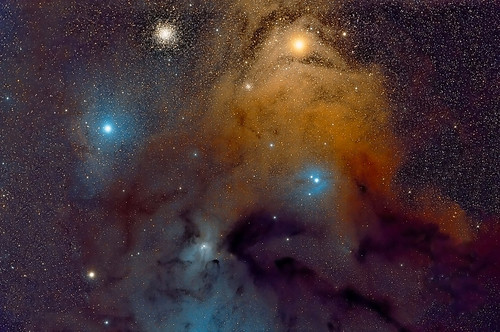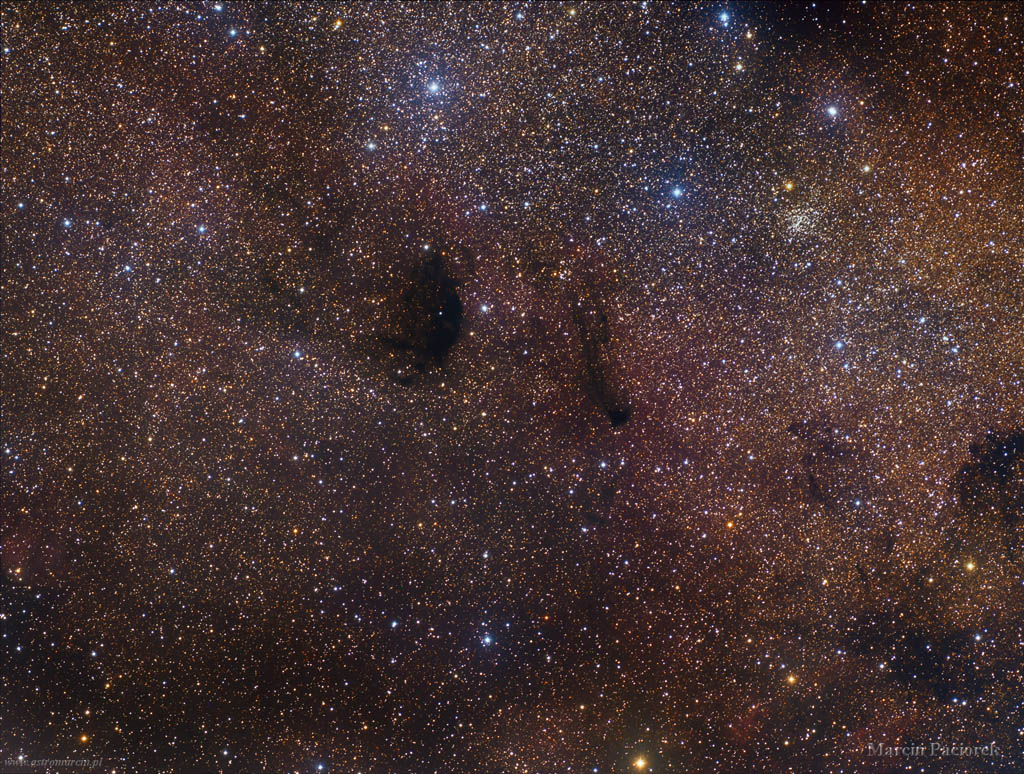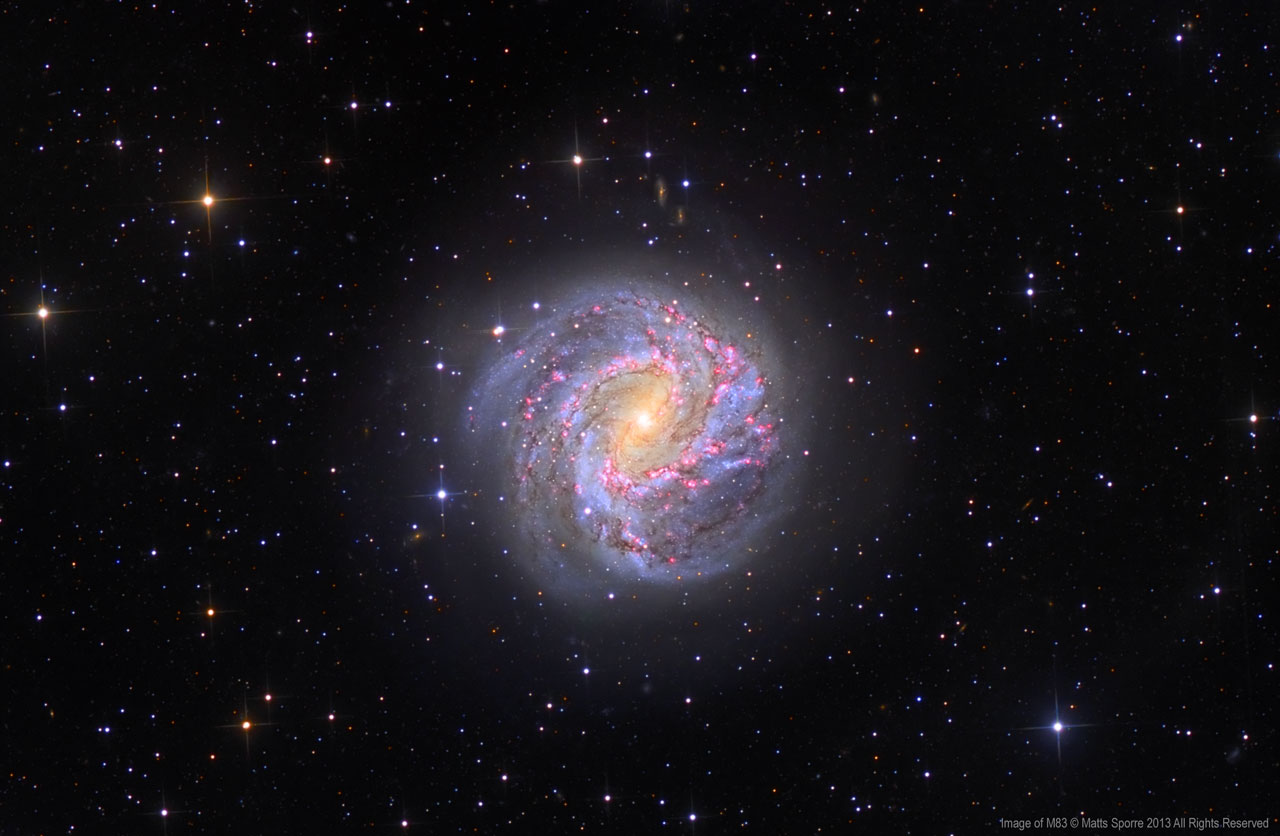Page 5 of 11
Re: Submissions: 2014 January
Posted: Mon Jan 13, 2014 9:58 am
by MaPa
B92 chasing B93
Copyright: Marcin Paciorek
http://www.astromarcin.pl
Looks like jellyfish chasing squid
Two objects from Barnard's catalog however there is also part of M24 visible here. I would never guess that Messier's list has something more than clusters, nebulas or distance galaxies...
More information about this session here:
http://www.astromarcin.pl/pages/b92_93.html
Re: Submissions: 2014 January
Posted: Mon Jan 13, 2014 3:20 pm
by mattssporre
The Southern PinWheel - M83 - NGC5236
http://www.istarion.net/index.html
Copyright: Matts Sporre
Bicolor Rosette with RGB stars
Posted: Mon Jan 13, 2014 6:05 pm
by tjugo
Hi,
Since I couldn't edit my original post I will add a new entry. Sorry

This image was created with the same data I created the HST version, but this time I only used the Ha and OIII in the following proportion:
Ha = Red, O3 = Green, 0.8*O3 + 0.2*Ha = Blue
Then to add some icing on the cake I replaced the stars with the RGB stars I captured with very short exposures.

A full review of the image (in spanish) can be found here:
http://mtanous.wordpress.com/2013/12/30 ... la-roseta/
Full details of the image (english captions) here:
http://mtanous.wordpress.com/ngc2244/
Thanks for looking!
Cheers,
Jose Mtanous
Re: Submissions: 2014 January
Posted: Mon Jan 13, 2014 7:44 pm
by astroligu
Rolando Ligustri wrote: comet C/2013 R1 Lovejoy, at 13/01/2014, wide field
link for high res,
http://www.astrobin.com/72599/
Re: Submissions: 2014 January
Posted: Mon Jan 13, 2014 8:36 pm
by IO_12
Tidal Streams in NGC 770, NGC 772 (Arp 78) - Interacting galaxies in Aries
http://www.irida-observatory.org
Copyright: [url=mailto://
info@irida-observatory.org]
Velimir Popov, Emil Ivanov[/url]
NGC 772 (also known as a peculiar spiral galaxy Arp 78) is an unbarred giant spiral galaxy approximately 106 million light-years away in the constellation Aries. It is notable for possessing a single elongated outer spiral arm. The asymmetric spiral arms are distorted by interaction with the dwarf elliptical galaxy NGC 770. NGC 770 appears to be at about the same distance as NGC 772, so it is most likely a true companion to the larger spiral system. It has a separation of only 160 000 light-years from its larger companion with an actual diameter of only about 40000 light-years.
LRGB combination - 15 hours
Annotated image
B / W image
Higher resolution and more information is available on the
website ...
Thank you for looking ...
http://www.irida-observatory.org
Re: Submissions: 2014 January
Posted: Mon Jan 13, 2014 8:48 pm
by IO_12
... some ideas what can be this nebulosity ?
Re: Submissions: 2014 January
Posted: Mon Jan 13, 2014 8:56 pm
by geckzilla
If you got a deeper image of it you might be able to find some star stream connecting it somewhere to NGC 772... otherwise, who knows. Dwarf galaxy? Local cirrus?
Re: Submissions: 2014 January
Posted: Mon Jan 13, 2014 10:33 pm
by IO_12
geckzilla wrote:If you got a deeper image of it you might be able to find some star stream connecting it somewhere to NGC 772... otherwise, who knows. Dwarf galaxy? Local cirrus?
Another 15 hours? May be, one day

To find conections with NGC 772 will be great but I doubt of this. My first assumption was a cirrus also but you are right, who knows.
Re: Submissions: 2014 January
Posted: Mon Jan 13, 2014 11:51 pm
by Meteocaravaca
Rho Ophiuchi
TSQ65APO + Canon 5D Mark II.
Copyright: Álvaro Pérez Alonso y Jose Manuel Pérez Alonso. Pérez Alonso Photography.
Facebook:
https://www.facebook.com/perezalonsofotografia
http://www.meteocaravaca.es

High resolution:
http://farm6.staticflickr.com/5529/1122 ... 76ff_o.jpg
Re: Submissions: 2014 January
Posted: Tue Jan 14, 2014 1:34 am
by Ann
IO_12 wrote:... some ideas what can be this nebulosity ?
A (somewhat remote) possibility is that it is a "galactic cirrus" wisp that is associated with the Milky Way rather than with NGC 772. Admittedly this wisp is far from the galactic plane.
Another possibility is that it is associated with NGC 772. If so, it doesn't look much like a dwarf galaxy, because I don't think it has the right shape for it. I note that it appears to be ever so slightly bluer in color and grainier in "texture" than the outer arms of NGC 772.
To me it looks like a wisp of gas, perhaps with a few stars inside it. It has the
striated appearance of the reflection nebulosity around the Pleiades, as if it was aligned along magnetic lines.
It
is possible that it is a dwarf companion of NGC 772. Look at
this image of NGC 4449 and dwarf companion by R Jay GaBany. Could your "wisp of nebulosity" be something similar to this tiny elongated mini-galaxy? Possibly, but let's bear in mind that NGC 4449 is an intrinsically small galaxy, much smaller than the Milky Way, whereas NGC 772 is a large galaxy, considerably larger than the Milky Way. If the wisp of apparent nebulosity that you have photographed is associated with NGC 772, then it must be relatively big, and much, much bigger than the tiny galaxy associated with NGC 4449.
Ann
Re: Submissions: 2014 January
Posted: Tue Jan 14, 2014 2:13 am
by geckzilla
I guess I make invisible posts. Anyway, it's not a good thing to go so far speculating about magnetic fields just because you see some lines.
Re: Submissions: 2014 January
Posted: Tue Jan 14, 2014 2:47 am
by kevin-palmer
Website:
http://www.kevin-palmer.com
Facebook:
https://www.facebook.com/KevinPalmerPhotography1
Copyright: Kevin Palmer
Thousands of stars forming the milky way galaxy are seen above a deep canyon in Utah. The Colorado River flows 2000 feet below the rim of Dead Horse Point into Canyonlands National Park. The bright light on the horizon is the planet Venus. There is no other object in the night sky brighter than Venus except for the moon, which had set only minutes earlier. The clear weather, dry air, and dark skies make this area one of the best in the country for stargazing.
http://farm8.staticflickr.com/7363/1182 ... 581b_o.jpg
On Flickr:
http://www.flickr.com/photos/kevin-palmer/11828347365
Re: Submissions: 2014 January
Posted: Tue Jan 14, 2014 2:49 am
by kevin-palmer
Website:
http://www.kevin-palmer.com
Facebook:
https://www.facebook.com/KevinPalmerPhotography1
Copyright: Kevin Palmer
The two brightest objects in the night sky appear side by side in front of the milky way in a rare alignment. Venus is the blue object, and the yellow object is the moon. Even though the moon was only an 8% crescent, it was brighter than Venus. The band of yellow along the horizon is from the last colors of twilight before it became completely dark. This incredible sky is framed over the Colorado River in Utah. The 2000 foot deep canyon is part of Canyonlands National Park. But this view was actually shot from the edge of a cliff at Dead Horse Point State Park.
http://farm4.staticflickr.com/3768/1182 ... 702c_o.jpg
On Flickr:
http://www.flickr.com/photos/kevin-palmer/11828347745
Re: Submissions: 2014 January
Posted: Tue Jan 14, 2014 7:27 am
by IO_12
geckzilla wrote:I guess I make invisible posts. Anyway, it's not a good thing to go so far speculating about magnetic fields just because you see some lines.
Thank you GECKZILA, thank you ANN

Obviously further investigations are needed but now the good visibility (down to 40 degrees altitude) of these objects is in a very short time window: 17:00 to 20:00 UTC. Probably a few more L frames in the next new moon period ...
Re: Submissions: 2014 January
Posted: Tue Jan 14, 2014 1:15 pm
by NBuer
*From the Northern to the Southern Cross*
This is a 30 image panorama taken from Laguna Cejar in Northern Chile. It is probably one of my most favourite astrophotos I have taken thus far mainly because it harbours many celestial delights.
Firstly we have our own galaxy, the Milky Way stretching all the way from Crux to Cygnus. In the middle of the photograph there is the Moon, the large bright object above the moon in Venus and below the moon if you look carefully there are two other 'stars', Saturn on the right and Mercury on the left.
On the far left we have the large and small Magellanic clouds, our closest galactic neighbours and finally the red hue on the left is airglow, which is an emission from excited OH radicals ~86km high.
 http://www.nicholasbuer.com/wp-content/ ... s-Buer.jpg
http://www.facebook.com/NicholasBuerPhotography
http://www.nicholasbuer.com
http://www.nicholasbuer.com/wp-content/ ... s-Buer.jpg
http://www.facebook.com/NicholasBuerPhotography
http://www.nicholasbuer.com
Re: Submissions: 2014 January
Posted: Tue Jan 14, 2014 6:09 pm
by thenews24
philto wrote:Hi to all and happy new year 2014 !
Pleiades occultation by moon July 18th 2009.
80 mm F/7 refractor + eos 350 D
4 images processed & fused by photomatix pro.
regards.
image © Philippe TOSI
Wow, how did you smoothly combine those exposures? Awesome work
Re: Submissions: 2014 January
Posted: Tue Jan 14, 2014 6:57 pm
by starsurfer
IO_12 wrote:... some ideas what can be this nebulosity ?
I think it is likely to be galactic cirrus nebulosity as there is lots of it in the direction towards Aries. Many galaxies in Aries have great clouds of galactic cirrus around them, most notably
NGC 918. There are also lots of high latitude dust clouds catalogued in Aries, most notably
LBN 762.
Re: Submissions: 2014 January
Posted: Tue Jan 14, 2014 10:13 pm
by IO_12
starsurfer wrote:IO_12 wrote:... some ideas what can be this nebulosity ?
I think it is likely to be galactic cirrus nebulosity as there is lots of it in the direction towards Aries. Many galaxies in Aries have great clouds of galactic cirrus around them, most notably
NGC 918. There are also lots of high latitude dust clouds catalogued in Aries, most notably
LBN 762.
Thank you STARSURFER, you are right. This is obviously a small patch of local cirrus. Today I also checked lots of images and this region is fully contaminated

Re: Submissions: 2014 January
Posted: Wed Jan 15, 2014 3:57 am
by sydney
Re: Submissions: 2014 January
Posted: Wed Jan 15, 2014 4:02 am
by sydney
Re: Submissions: 2014 January
Posted: Wed Jan 15, 2014 4:06 am
by sydney
Re: Submissions: 2014 January
Posted: Wed Jan 15, 2014 4:10 am
by sydney
The first post
Posted: Wed Jan 15, 2014 6:11 am
by adonoan
Night of Mongolia plains
I shot this photo last month in Mongolia plains.
This night was a temperature of about -35 ℃.
Copyright: Naoyuki Noda
Website:
http://adonoan.com
Facebook:
https://www.facebook.com/naoyuki.noda.7
Re: Submissions: 2014 January
Posted: Wed Jan 15, 2014 11:10 am
by Fabrizio Francione
Hello,
A Meteor shower ,probably a Quadrantids residue ,received using the reflection of the GRAVES radar signal situated in north of France and captured in Turin with a simple omnidirectional antenna and a PCR1500 receiver in CW . We've added a new monitoring station H24, available for everybody here :
http://www.sidmonitor.net/gallery/station.html bottom page (refresh if it doesn't appear.) On the live spectrogram are clearly visible many traces of planes and the vertical lines that you see are meteors. Audio of the first image here :
http://chirb.it/xfOIPB
AIR - CSP- Fabrizio Francione- Renato Romero- Claudio Re.
Jupiter Moon Conjuction with a Lunar Halo
Posted: Wed Jan 15, 2014 2:17 pm
by nuclearcat
Taken from Middle East Technical university campus in Ankara on 14.01.2014
Copyright: M. Raşid Tuğral






















